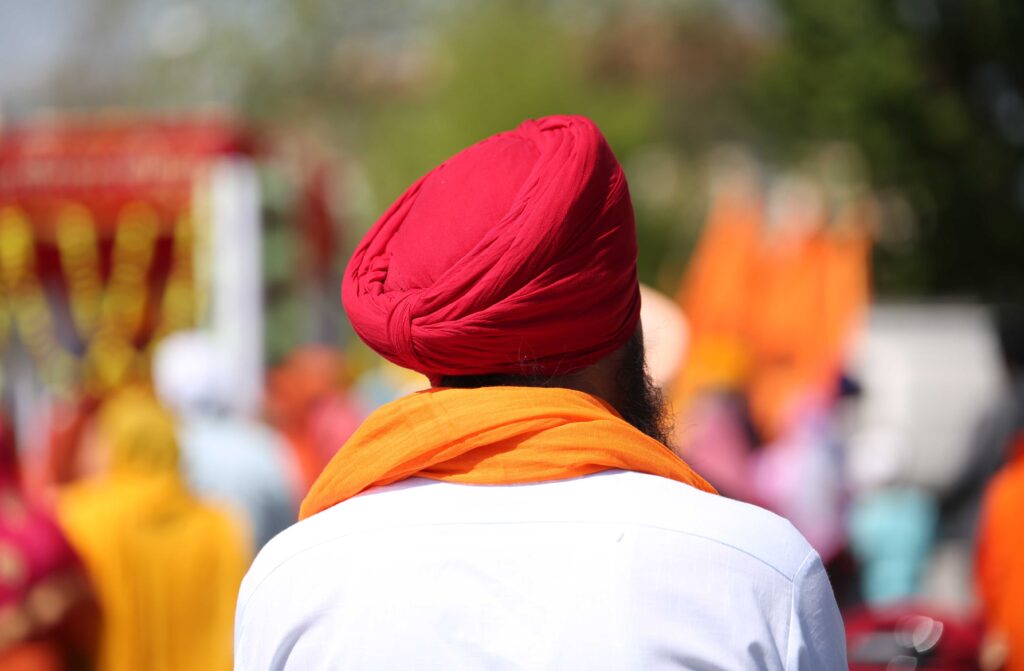Sikh funerals
Sikhism is an eastern religion that originated in the Punjab region of southern Asia. Similar to Hinduism, Sikhs believe in reincarnation and karma, and think the purpose of life is to gain enlightenment through meditation and the teachings of the gurus.

Sikh beliefs about death
According to Sikhism, death is a natural process, it’s only the physical body that dies, and the soul lives on through transmigration and reincarnation. For them, the purpose of life is to move closer to Waheguru, the Sikh name for God, and that death will help break the cycle of reincarnation. They believe that through good deeds, honesty and Waheguru’s grace (nadar), the soul will eventually leave this earth to be united with the ‘Wondrous Giver of Knowledge’.
Sikh cremation
As with many Asian religions, Sikhs believe that the physical body serves no purpose but to house the soul. For that reason, cremation is usually preferred, but burying is also accepted. However, no headstone or monument is allowed. This is because through reincarnation, the soul has already passed into another body and therefore it is only the shell that remains. Instead, to commemorate their loved one, Sikhs will scatter the ashes of the deceased over water or a place of significance.
How long after death is a Sikh funeral?
Arrangements for a Sikh funeral usually begin immediately after death, ideally within three days. Before the funeral service, the body of the deceased is washed and dressed. If the deceased had been baptised, they are dressed in their karkars, the five articles of Sikh faith. These include:
- Kesh (uncut hair)
- Kangha (a small wooden comb)
- Kachha/kachhehra (an undergarment, usually shorts)
- Karha (an iron bracelet)
- Kirpan (a sword/dagger)
Additionally, the body of the deceased is surrounded by flowers, usually orange and white chrysanthemums which are the mourning flowers in many parts of Asia.
Do Sikhs go to temple before a funeral?
Sikhs believe in mourning quietly and privately; they are discouraged from showing public displays of emotion. Instead, to mourn the loss of a loved one, the friends and family members will gather at the gurdwara where hymns are sung and funeral prayers recited. This is to show their dedication to God and accept his decision to take their loved one away.
What happens at a Sikh funeral?
The Sikh funeral is known as ‘Antam Sanskaar’, which translates as ‘final rite’ or ‘the last rite of passage’. The service does not focus on the pain or grief of losing a loved one, but treats it as a celebration of the soul. For this reason, a Sikh funeral service is usually fairly simple.
The funeral ceremony can happen in a number of places including: the family home, at the gurdwara, outside, or at the crematorium. Traditionally, a Sikh funeral will include a community prayer, ‘Ardas’, as well as two daily prayers, ‘Japji’ and ‘Kirtan Sohila’. It is a very religious ceremony so long or emotional eulogies from the bereaved family are discouraged; they believe this goes against the belief that the physical body is merely a vessel for the soul.
Can you wear black to a Sikh funeral?
If you are wondering what to wear to a Sikh funeral, it is funeral etiquette to wear smart, modest clothing. White is traditionally the colour of mourning in most Asian cultures, but if the funeral takes place in a western country, black, navy or grey is more common. If you’re unsure what colour to wear, it’s best to check with the family of the deceased. Additionally, head coverings are usually worn by both gender and shoes must be removed upon entering gurdwara, or Sikh homes.
Do you send flowers to a Sikh funeral?
Flowers and donations are not considered part of the Sikh funeral rites, however, if you would like to send flowers, it’s best to check with the family of the deceased first.
Do Sikh funerals have a wake afterwards?
After the funeral ceremony, the friends and family of the deceased will come together to read the Sri Guru Granth Sahib, the Sikh holy scripture. This ceremonial reading is known as the ‘Akhand Paatth’ and takes place at the family home or the gurdwara. It’s commonly read in a single sitting over three days, or across a longer period, usually ten days. On the first anniversary of a death, the bereaved family gathers together to pray, eat, and celebrate the life of the one they have lost.
What happens at a cremation service?
Cremations are fast becoming the norm in Britain with over 70% of families choosing this type of funeral.
Repatriation
When someone passes away in the UK, the process of repatriating someone to another country can be a complicated task for anyone to deal with.
Step by step guide
There are several steps in the Funeral Planning process you will have to consider.
Further Reading: Arranging a funeral
Read about how funerals are arranged and what services you can expect to get.